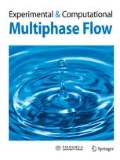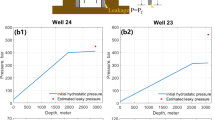Abstract
Existing well control prediction techniques have not yet found wide acceptance in slim holes. This study investigates the two-phase transient pressure behavior when a gas kick occurs in slim holes. This paper presents an improved two-phase model that will account for the change in annular pressure transients. The two-phase model is based on the drift-flux model. Newly developed drift-flux correlations with specific target to narrow annuli are applied. An explicit scheme is adopted to solve the two-phase model. Results show the high inaccuracies that occur from using conventional models instead of this new model. The velocities of each phase are seen to increase tremendously with assumption of slim holes. This in turn causes significant increase in the equivalent circulating densities (ECDs) and underestimation of bottom hole pressures. On the other hand, the hydrostatic pressures are seen to decrease as well leading to a counterbalance. Pressure signatures for slim holes are seen to shift to the right consequently affecting the void fraction distribution and other fluid properties. Case studies are performed in the simulations to examine the effect of varying annulus ratio on results for constant influx and mud rate. From the results, as annulus ratio goes beyond 0.8, the changes in bottom hole ECDs become much more substantial. The understanding of hydraulics in narrow annuli is vital for real-time pressure prediction during a gas influx. This study provides an improved simulation tool for more accurate prediction of influx behavior in slim holes.
Similar content being viewed by others
Change history
05 February 2022
A Correction to this paper has been published: https://doi.org/10.1007/s42757-022-0132-z
References
Avelar, C. S., Ribeiro, P. R., Sepehrnoori, K. 2009. Deepwater gas kick simulation. J Petrol Sci Eng, 67: 13–22.
Beggs, H. D., Brill J. P. 1973. A study of two-phase flow in inclined pipes. J Petrol Technol, 25: 607–617.
Bestion, D. 1990. The physical closure laws in the CATHARE code. Nucl Eng Des, 124: 229–245.
Bode, D. J., Noffke, R. B., Nickens, H. V. 1991. Well-control methods and practices in small-diameter wellbores. J Petrol Technol, 43: 1380–1386.
Choe, J. 2001. Advanced two-phase well control analysis. Journal of Canadian Petroleum Technology, 40: 774–782.
Choi, J., Pereyra, E., Sarica, C., Park, C., Kang, J. 2012. An efficient drift-flux closure relationship to estimate liquid holdups of gas–liquid two-phase flow in pipes. Energies, 5: 5294–5306.
Delwiche, R. A., Lejeune, M. W. D., Mawet, P. F. B. N., Vighetto, R. 1992. Slimhole drilling hydraulics. In: Proceedings of the SPE Annual Technical Conference and Exhibition: SPE-24596-MS.
Dupuis, D., Augis, D., Sagot, A., Delahaye, T., Cartalos, U., Burban, B. 1995. Validation of kick control method and pressure loss predictions on a slim hole well. In: Proceedings of the SPE/IADC Drilling Conference: SPE-29348-MS.
Guo, R. X., Chen, Y. H., Waltrich, P. J., Williams, W. C. 2018. An experimental investigation on flow pattern map and drift-flux model for co-current upward liquid–gas two-phase flow in narrow annuli. J Nat Gas Sci Eng, 51: 65–72.
Ishii, M. 1977. One-dimensional drift-flux model and constitutive equations for relative motion between phases in various two-phase flow regimes (No. ANL-77-47). Office of Scientific and Technical Information.
Jowitt, D., Cooper, C. A., Pearson, K. G. 1984. The THETIS 80% blocked cluster experiment. Part 5: Level swell experiments (No. AEEW-R—1767). UKAEA Atomic Energy Establishment.
Leblanc, J. L., Lewis, R. L. 1968. A mathematical model of a gas kick. J Petrol Technol, 20: 888–898.
Nickens, H. V. 1987. A dynamic computer model of a kicking well. SPE Drilling Engineering, 2: 159–173.
Prince, P. K., Cowell, E. E. 1993. Slimhole well kill: A modified conventional approach. In: Proceedings of the SPE/IADC Drilling Conference: SPE-25707-MS.
Santos, O. L. A. 1991. Well-control operations in horizontal wells. SPE Drilling Engineering, 6: 111–117.
Shanks II, F. E., Williams, K. R. 1993. Slimhole exploration requires proper technical preparation. In: Proceedings of the SPE Annual Technical Conference and Exhibition: SPE-26337-MS.
Wang, Z. H., Peden, J. M., Lemanczyk, R. Z. 1994. Gas kick simulation study for horizontal wells. In: Proceedings of the SPE/IADC Drilling Conference: SPE-27498-MS.
Wang, Z. Y., Sun, B. J. 2009. Annular multiphase flow behavior during deep water drilling and the effect of hydrate phase transition. Petrol Sci, 6: 57–63.
Zuber, N., Findlay, J. A. 1965. Average volumetric concentration in two-phase flow systems. J Heat Transf, 87: 453–468.
Author information
Authors and Affiliations
Corresponding author
Rights and permissions
About this article
Cite this article
Nwaka, N., Liu, J., Kunju, M. et al. Hydrodynamic modeling of gas influx migration in slim hole annuli. Exp. Comput. Multiph. Flow 2, 142–150 (2020). https://doi.org/10.1007/s42757-019-0038-6
Received:
Revised:
Accepted:
Published:
Issue Date:
DOI: https://doi.org/10.1007/s42757-019-0038-6




